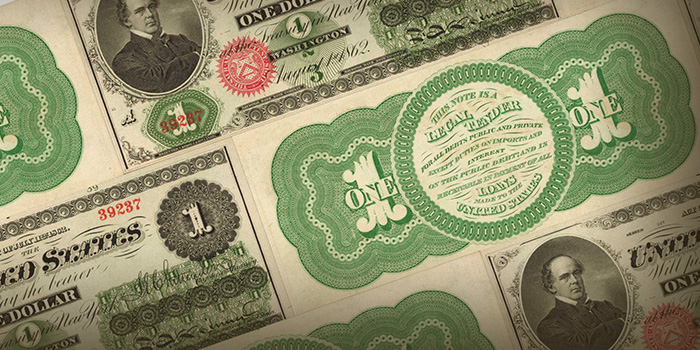
By Q. David Bowers – Co-founder, Stack’s Bowers ……
All across the market, excitement continues to build for our forthcoming sale of the Joel R. Anderson Collection of large-size paper money types. Part 1 will cross the block March 22, 2018, at the Whitman Coin & Collectibles Expo in Baltimore–always one of the top shows of the year. The notes will be showcased in a special catalog as well as at StacksBowers.com.
The Anderson Collection by definition includes notes from affordable and available to great rarities–among the last being unique and, often, the finest known.
Today’s showcase note is a variety that is at once very historical and also affordable in lower grades. As might be expected, the Anderson note, while not the rarest of the rare, is among the very finest of its issue—tied for the finest certified by PCGS Currency—a condition rarity deluxe!
From Bowers and Merena’s sale of January 1991, lot 825; Heritage Auctions’ sale of January 2003, lot 18203; Heritage Auctions’ sale of September 2006, lot 18267:
- $20,000-$25,000
- Finest PCGS 1862 $1 Legal Tender Note
- Lot 1003. Friedberg 16 (W-9). 1862 $1 Legal Tender Note. PCGS Currency Superb Gem New 67 PPQ.
This superbly preserved 1862 $1 Legal Tender Note comes from the top position of the original four-subject sheet, and still retains a little extra sheet selvage in the top margin. The paper is pristine, creamy white in color and fully original. The National Bank Note Company printed design is sharply detailed and darkly inked. Cherry red overprints are seen and contrast nicely with the rich green security tints. The ornate green printed back is also well detailed. This note is tied with one other at this grade level at PCGS with none finer. This is an incredibly important opportunity to acquire one of the finest examples of our first federal $1 type, an excellent Condition Census example of a popular note. Only a couple of people may own one of this caliber and it may be that no finer specimen exists!
PCGS Population: 2; none finer.
Legal Tender Notes
Legal Tender Notes, as they are generally called, were mostly imprinted with “United States Note” at the border. These were born of necessity for, after December 28, 1861, gold coins disappeared from circulation, and a widely accepted paper-money medium was needed, to replace the circulating Demand Notes payable in gold. Going into 1862, it was not clear which side would win the Civil War. In England, where the Confederacy sold many bonds denominated in British pounds, there was great sentiment for the South, the supplier of cotton to that nation’s textile mills.
On January 29, 1862, in a letter to the Committee of Ways and Means, Secretary of the Treasury Salmon P. Chase stated that he had an aversion to issuing paper money not exchangeable in gold or silver coins at face value, but the government supply of such coins was very low. In the meantime, expenses for the war mounted to levels no one had predicted. The solution was to issue Legal Tender Notes that would circulate in commerce, but were exchangeable at face value only for other Legal Tender notes or for the bills of state-chartered banks (which remained in circulation throughout the war).
The first Legal Tender Notes are dated March 10, 1862, and were issued in denominations from $5 to $1,000, followed by those dated August 1, 1862, that had values of $1 and $2. Printing was done by the American Bank Note Company. Most circulation of Legal Tender Notes consisted of the lower denominations of $1, $2, $5, $10, and $20.
Legal Tender bills depreciated from the very beginning. Soon, a double system of pricing arose in the marketplace–a higher price if paid in Legal Tender bills, a lower one if gold or silver coins were tendered in payment. Indeed, at the outset, there were many merchants who would not accept Legal Tender Notes at all and demanded coins. Not even the Philadelphia Mint would accept Legal Tender Notes in payment at par for the Proof coins it struck for collectors, a situation that endured for many years. To buy such pieces, numismatists had to buy older silver and gold coins from an exchange broker and submit them to the Mint in payment. The height of deprecation was in 1864 when it took $1,000 in Legal Tender Notes to buy $387 face value of gold coins.
In the Confederacy, the situation was even worse, and toward the end of 1864 it took $2,174 in Confederate bills to buy $100 in federal coins (which remained highly regarded in the South).
Large-size Legal Tender Notes were later produced in various designs culminating with the Series of 1923.
The Joel R. Anderson Collection includes outstanding examples of all of the types, including incredibly rare $500 and $1,000 values.
–Dave Bowers





My 1862 $1 Legal Tender note has National Bank Note Company monogram printed on the face of the note, TWICE.
This note is graded by PCGS Currency: 58 Choice About New
The holder is printed with three comments:
No ABNCo. Monogram; No Patent Date; Series ar right.
Your article: “Focus on the Classic Affordable $1 1862 Legal Tender note,” states:
“These notes were printed by American Bank Note Company.”
Please explain why my not does not have the American Bank Note monogram? Thank you!